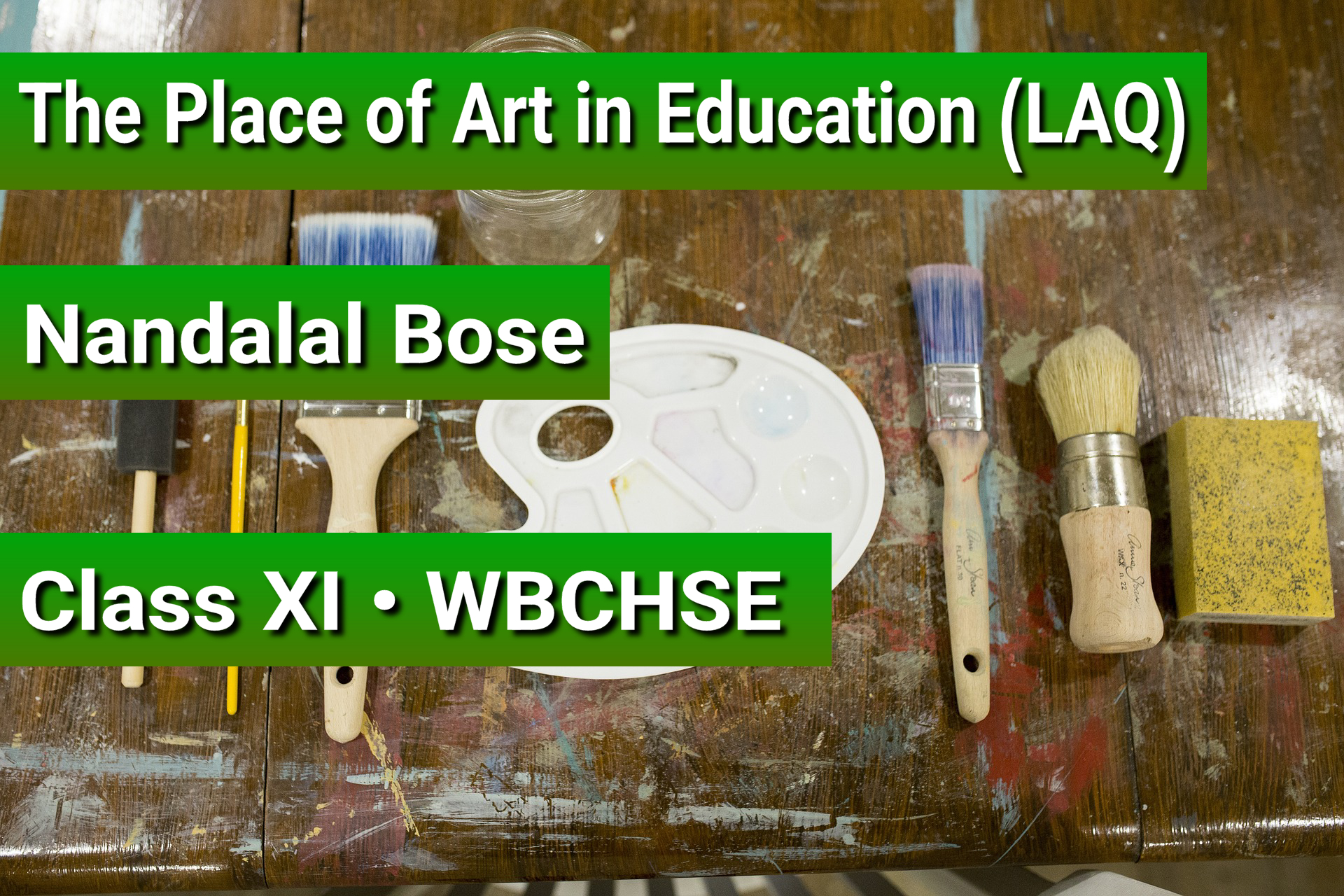The Place of Art in Education Questions and Answers
The Place of Art in Education Long Questions and Answers

The Place of Art in Education LAQ
1)What is the difference between fine art and functional art? [5] [Annual Exam. = 2014]
Ans. There are two sides to art – fine art and functional art. Fine art liberates our minds from the constraints of sorrows and conflicts of our daily lives. It is created with the primary purpose of expressing an artist’s ideas, emotions, or thoughts. It gives us aesthetic delight and makes our lives easy and tolerable. Examples of fine art include paintings, sculptures, and installations. Functional art, on the other hand, is created with both aesthetic value and practical use in mind. It brings beauty to the objects of our daily use. It provides us with means of livelihood. It is concerned with professional returns. Examples of functional art include ceramics, glassware, and furniture.
3)How does a poor Santhal express his sense of beauty and order. [5] [Annual Exam. = 2015]
Ans. There are some people who think that art is the domain for rich and pleasure-loving. That is why they want to banish art from their daily lives. According to Nandalal Bose, the vitality of a work of art lies in its sense of beauty and order, not in its monetary value. In support of his point of view, the author gives the example of a poor Santhal who has sense of beauty. He sweeps and mops his hut and stacks his earthen pots and tattered quilts in order. On the other hand, an educated college student keeps his clothes and things in a disorganised mess in his seemingly palatial hostel room or lodging. This comparison demonstrates how important a sense of beauty and order is to the underprivileged Santhal.
3)According to Nandalal Bose how can the aesthetic sensibilities of the students be increased? [5] [Annual Exam. = 2016]
Ans. Nandalal Bose emphasized the need to develop the aesthetic sensibilities of students by integrating art into their daily lives. Students should be introduced to good paintings, sculptures and other specimens of fine and functional arts by displaying them in the classroom, libraries, studies and living room. This will help them appreciate the diversity and richness of art. They should watch films with selected examples of the art of our country and other countries from time to time. They should visit museums and pictures galleries accompanied by qualified teachers. Paintings, sculptures and distinguished examples of the art of the past will train their eyes and strengthen their power of discernment and gradually awaken their aesthetic sensibilities. Students should be encouraged to observe the beauty in nature and their surroundings like the season’s fruits and flowers.
4)According to Nandalal Bose how does the absence of a sense of beauty affect the society? [5] [Annual Exam. = 2017]
OR,
According to Nandalal Bose, how are beauty and aesthetics connected to a person’s physical and mental well-being? Explain with the example from the text? [5] [Annual Exam. = 2018]
Ans. According to Nandalal Bose, the absence of a sense of beauty in society can have a detrimental effect on its cultural, social, and moral fabric. He believed that a society that fails to appreciate beauty, art, and aesthetics is deprived of an essential element that can enrich human life. People who lack the sense of beauty litter rubbish in their houses and courtyard. They keep themselves and their surroundings filthy, spit betel juice on their walls, street and even railway coaches. Thus, they contaminate society with diseases and with their despicable standards of behaviour.
Click Here To Get The Chapter Wise Questions And Answers Of Class XI, WBCHSE
5)What example did Nandalal Bose give to support his view that “the vitality of work of art lies in its sense of beauty and order.” [5] [Annual Exam. = 2019]
Ans. Nandalal Bose believed that a work of art’s vitality was not determined by its monetary value, but rather by its feeling of order and beauty. To bolster his arguments, he draws comparisons between a well-educated college student and a destitute Santhal. A Santhal scrubs and mops his cottage in poverty. He arranges his worn-out comforters and earthen pots in heaps. But in his or her ostensibly luxurious hostel room or lodging, an educated college student maintains their clothes and belongings in a disorganised mess. Even shirts are hung from picture frames, while combs and teacups are scattered across study tables. Even their sense of style is lacking. While the appreciation of beauty is merely aesthetic to the rich man’s offspring, it is an integral aspect of existence for the poor Santhal.
6)Why is ‘encounter with Nature’ is important for the learners? How can they be introduced to Nature? [2+3 = 5] [Annual Exam. = 2020]
Ans. For the students, “Encounter with Nature” is crucial since it sharpens their aesthetic senses. Nandalal Bose asserts that living in close proximity to and observing nature are the foundations of art education.
By hosting periodic festivals and presenting various natural objects, such as the fruits and flowers of the season, students can be introduced to nature. They will experience firsthand the rice fields, lotus ponds, Palash, shimul, and other sights. To become more familiar with nature, special holidays should be established and picnics and sports should be held.

